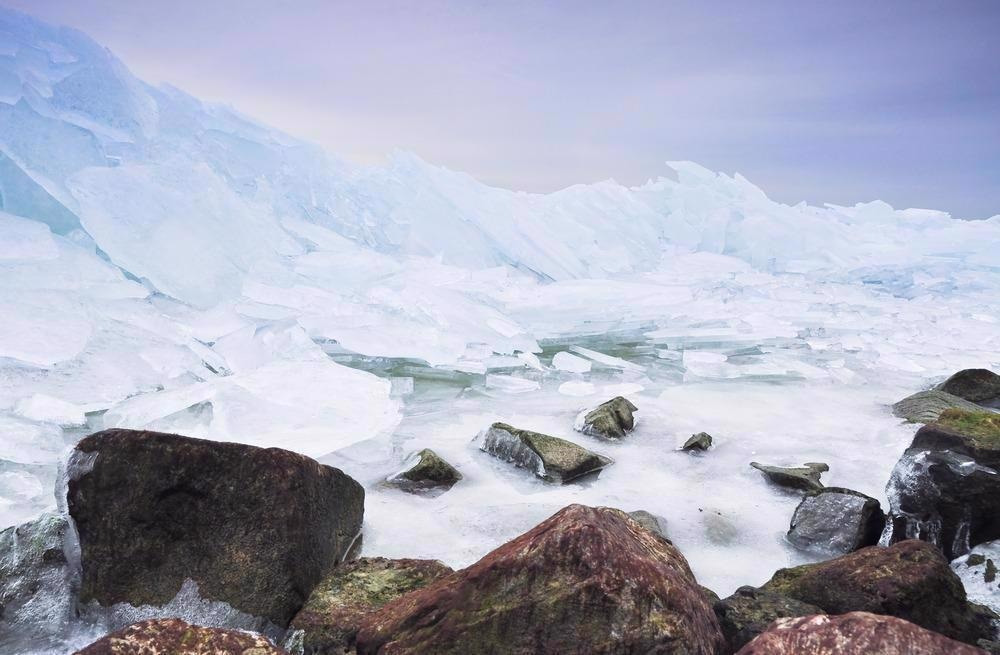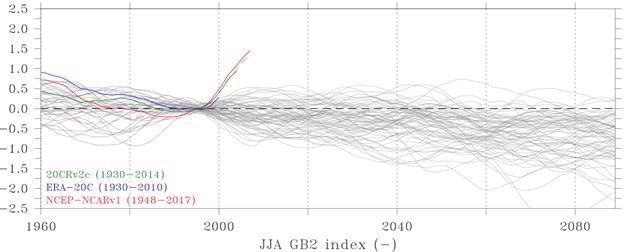AZoCleantech speaks to Dr. Francois Lapointe from the University of Massachusetts about his team's research into the Little Ice Age. The team has indicated that major volcanic eruptions and the intrusion of warm Atlantic waters into the Nordic Seas in the late 1300s were significant factors that may have caused the Little Ice Age.
How did you begin your research into the Little Ice Age? Can you tell the readers a little bit about your study and how it was carried out?
I am particularly interested in highly resolved paleoclimate records to understand which mechanisms are at play in triggering rapid climate change. To do so, I use annually laminated sediments from lakes (varves) in the Arctic.
One lake record situated on Ellesmere Island, Canada, has strong compatibility with the Atlantic multidecadal oscillation (AMO) or variability (AMV). Since 1856, measured North-Atlantic SST depicts a multidecadal variability termed the AMV.
The North-Atlantic alternates between warmer and cooler conditions following a 40-80 year SST pattern, and these fluctuations strongly correlated with the varve record, and amazingly it spans the past ~3000 years, meaning that we have a unique proxy record of the AMV for the past 3 millennia (Lapointe et al. 2020).
What is driving these fluctuations is of great interest because the AMV is linked with droughts in the Sahel, hurricane frequency in the Atlantic, and precipitation anomalies in South America. Hence, having data that span the past three millennia is of huge help in understanding the AMO evolution in the past and will help decipher the main drivers of its fluctuations as well as how it may evolve in the future.
By examining this reconstructed AMV meticulously, an apparent striking feature was the sudden change from very warm conditions at the end of the 1300s to unprecedented cold conditions in the early 1400s. This abrupt climatic cooling occurred within 20 years, which is less than a human lifetime, and as such, it is important to understand how it happened.
According to your team’s study results, what do you now believe caused the Little Ice Age, lasting from the early 15th to mid-19th centuries?
Our result implies that the main phase of the Little Ice Age occurred in the early 1400s. However, one must keep in mind that there were other cold periods before the 1400s and the “Medieval Climate Anomaly (MCA)”, but they were shorter and warmer than the one we documented from 1400-1600s.
These shorter episodes prior to the 1400s were mostly linked with sudden major volcanic eruptions. Tiny aerosol particles from large eruptions cool the surface of the Earth by reflecting solar radiation back to space. The strongest volcanic eruption of the past millennium, the Samalas eruption from Indonesia in 1257, likely triggered the “first” significant cooling event after the MCA but lasted less than a century.
For the main phase of the Little Ice Age, we provide strong evidence that it was triggered by the intrusion of warm Atlantic waters into the Nordic Seas in the late 1300s, in a time when thick and extensive sea ice prevailed in the Arctic.
This warm intrusion peaked around 1380 of our time, and this was linked with a persistent atmospheric blocking over the North Atlantic that was particularly important over South Greenland as inferred from proxy records. In modern times, our AMV co-varies strongly with periods of higher atmospheric pressure in the Atlantic since the 1800s. Thus, the AMV captures these blocking events.
By comparing our reconstructed AMV with the most recent annually resolved solar activity from tree-rings spanning the last millennium, we discovered a remarkable co-variability between both datasets. Most notably, the late 1300s was characterized by unusual high solar forcing that coincided with few or any major volcanic eruptions at that time. Hence, a “cleaner” atmosphere meant that the planet was more responsive to changes in solar output. Several studies highlight that high solar activity can trigger atmospheric blocking in the Atlantic, so this would be coherent with what could have occurred around 1380.
This blocking anomaly allowed arctic sea ice to accumulate in the arctic high latitudes, and upon the weakening of the blocking, a flush out of arctic sea ice occurred. Arctic sea ice was then exported to the lower latitudes, freshening the North Atlantic in the early 1400s.
There is a well-known process of overturning circulation in the North Atlantic called the Atlantic Meridional Overturning Circulation (AMOC). The AMOC can be viewed as a planetary conveyor belt: Typically, warm water from the tropics flows north along the coast of Northern Europe, and when it reaches higher latitudes it loses heat and becomes denser as the water is saltier and colder. Hence, the massive export of sea ice in the early 1400s caused the salinity to drop sharply in the subpolar gyre, weakening the AMOC.
Our findings show that the abrupt onset of the Little Ice Age occurred in the early 1400s. However, this mechanism cannot explain two centuries of lower temperatures. Other climatic feedbacks, principally an increase in major volcanic eruptions and lower solar irradiance, helped to maintain this cooling period for such a long time.
What were the consequences of this cold era?
Winter temperatures in Europe were bitter cold, preventing harvesting and resulting in misery and death for millions. There is also strong evidence of glacier advances in many places around Europe, America, and South America.

Image Credit: MariskaVegter/Shutterstock.com
Interestingly, written archives document European populations linking magic and weather-making just as the little ice age started (Behringer 1999). Periods of stronger volcanic eruptions during the Little Ice Age also coincided with peaks of persecution of “witches” who were blamed for destroying crops. The Norse populations also started to abandon their habitations in South Greenland in the early 1400s.
How was the planet able to recover from the Little Ice Age?
In the Northern Hemisphere, a long-term cooling trend started ~5000 years ago in response to decreasing summer insolation in the high latitudes. The coldest temperature culminated in the Little Ice Age. This natural cooling trend was abruptly reversed by the increase of greenhouse gases from burning fossil fuels starting in the 20th century.
From a regional perspective, the subpolar gyre region recovered from the Little Ice Age, probably from a combination of reduced volcanic activity and higher solar irradiance, such as in the mid-1700s. However, large volcanic eruptions, such as the well-known Tambora eruption in 1815, have paced other strong cooling events.
What has caused AMOC strengthening to occur between the 1950s and 1960s?
This is still unknown, what we know is that the AMOC weakened in the 1980s, which may be linked to the input of anthropogenic aerosols that would have induced "global" cooling in the 1980s. Another hypothesis is the large arctic sea ice export to the North-Atlantic in the 1970s following the atmospheric blocking of the 1960s. It is hard to firmly conclude this assumption as satellite measurement of arctic sea ice only began in 1979. The combination of both artificial aerosols input by human activities and melting arctic sea ice in the North-Atlantic may have weakened the AMOC, but this is still yet to be proven.
Interestingly, one of the highest solar activities peaked around 1957. Evidently, anthropogenic aerosols and greenhouse gases play an important role in atmospheric circulation in our time. An open question is what would be the effect of a stronger solar activity on the atmospheric pressure pattern and if this had any implications with the AMOC strengthening of the 1950s-1960s. We only began to monitor our sun around 40 years ago, and more sophisticated analysis will hopefully give better insights into sun climate relationships in the past as well as in modern times.
Could a similar abrupt cooling event occur again in our age of global climate change?
There is now much less sea ice in the Arctic than in the 1300s because of human-caused global warming. But persistent periods of high pressure over Greenland (Greenland Blocking) in summer have been much more frequent since 2005 and they are linked with record-breaking ice sheet melting.
I conducted fieldwork during summer 2019 on Ellesmere Island in the Canadian High-Arctic, west of Greenland. Clear sky conditions caused a real heat dome over us as we recorded temperatures as high as 24 ˚C for several days in a row. During the same year, Greenland Ice Sheet lost more than 500 billion tons of mass, a record. This higher trend in Greenland Blocking is reproduced by none of the Coupled Model Intercomparison Project (CMIP) models (Hanna et al. 2018), which I find worrying. If that trend continues, we are definitely underestimating future ice loss from the Greenland ice sheet, which would potentially lead to a shutdown of the AMOC sooner than anticipated.

Time series of June to August Greenland Blocking (red line) over 1950-2015 as simulated by NCEP/NCAR Reanalysis 1 and other reanalysis datasets. CMIP5 models (grey lines) for which RCP4.5 and PRC8.5 scenarios are available. Image Credit: Hanna et al. (2018)
There is also the build-up of freshwater in the Beaufort Sea (north of Alaska) which has increased by 40% in the past 20 years. Its export to the subpolar North-Atlantic could also have a strong impact on oceanic circulation.
What can we do to address the uncertainties surrounding the current AMOC?
The AMOC acts like a planet thermostat in regulating the temperature between the low and high latitudes of the Atlantic. It also helps maintain milder conditions in Europe compared to other areas at the same latitudes. How the AMOC will respond to ongoing climate change is one of the most important topics in climate science.
There is some evidence that the AMOC is weakening with global warming, although it has only been monitored since 2004, and so we do not know much about it. We crucially need to better understand tipping points associated with the AMOC. This can only be done by analyzing highly resolved records (preferably sub-decadal temporal resolution) from key areas, not only in the North-Atlantic but also in the Nordic Seas where the influence of the AMOC may be greatly underestimated (Zhang and Thomas 2021).
About Dr. Francois Lapointe
 Francois is a postdoctoral research associate at the University of Massachusetts working with distinguished professor Raymond S. Bradley.
Francois is a postdoctoral research associate at the University of Massachusetts working with distinguished professor Raymond S. Bradley.
He works on annually laminated sediments from arctic lakes to retrieve crucial information about environmental changes. He completed his Ph.D. at the National Institute for Scientific Research, University of Quebec, where he received the Weston Garfield award for outstanding contribution to Canada in northern research.
Over the past decade, Francois has conducted fieldwork in the Canadian Arctic as well as in Svalbard. He also teaches Climate Dynamics and supervises projects from undergraduate students.
Dr. Lapointe is currently investigating hydroclimate shifts in Svalbard, one of the regions most impacted by climate change.
Disclaimer: The views expressed here are those of the interviewee and do not necessarily represent the views of AZoM.com Limited (T/A) AZoNetwork, the owner and operator of this website. This disclaimer forms part of the Terms and Conditions of use of this website.